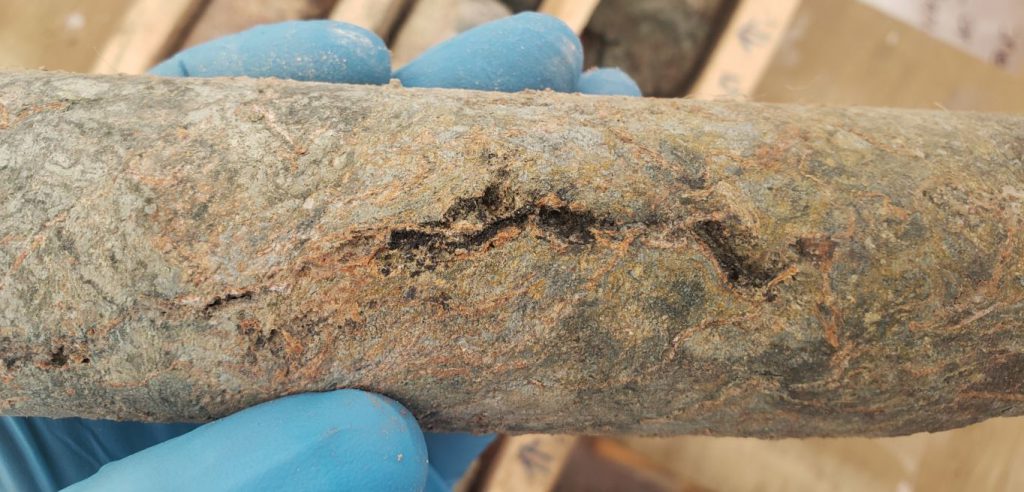Baselode Energy completes Hook drill program, Saskatchewan

Baselode Energy Corp. [FIND-TSXV; BSENF-OTCQB] has completed the diamond drilling program on the Ackio high-grade uranium zone on the 100%-owned Hook project, northern Saskatchewan.
“Several of our holes intercepted elevated levels of radioactivity, which will expand our mineralized footprint. We also achieved several milestones, including extending mineralization along strike and at depth, discovering more shallow mineralization, including Pod 7 starting at the overburden-basement rocks contact similar to Pod 1, defining thicker zones of mineralization within previously modelled areas, and identifying a new trend of mineralization at the Mirror target, which displays intense alteration over a 300 metres width,” said James Sykes, CEO, president and director.
Thirty-six drill holes over 7,512 metres were completed. Within this, Ackio consisted of 30 drill holes for 6,193 metres, Mirror consisted of 5 drill holes for 1,145 m (AK23-105 to AK23-109), and 1 drill hole (HK23-008) for 174 m was completed on a regional exploration target.
Drill holes AK23-112 to AK23-113 successfully identified mineralization at the overburden-basement contact in Pod 7, confirming a second zone of mineralization (after Pod 1) with mineralization as-shallow-as-possible in the Ackio system.
Drill holes AK23-114 and AK23-115 tested the northern strike extent of mineralization in Pod 7. Results were strongest in AK23-114 suggesting Pod 7 could trend shallower than previously modelled and requires follow-up in the future.
Drill hole AK23-116 confirmed numerous discrete intervals of elevated radioactivity in the area between Pods 1 and 7. These intervals are not part of any currently modeled uranium Pods (Pods 1 through 11) and could help increase the overall volume of mineralization identified at Ackio.
Seven of the reported drill holes (AK23-107, AK23-111 to AK23-116) all had mineralization starting shallower than 100 m from surface, with three drill holes intersecting mineralization shallower than 50 m from surface (AK23-111 to AK23-113).
High levels of radioactivity (>5,000 cps*) were reported in drill holes AK23-112 and AK23-116. The results from AK23-112 confirms strong uranium mineralization can be projected to the overburden-basement contact in Pod 7, and AK23-116 supports the potential for additional high-grade uranium mineralization occurring between Pods 1 and 7.
Drill holes AK23-105 to AK23-109 were all drilled in the Mirror target area. Two of the reported drill holes (AK23-105 and AK23-107) intersected elevated radioactivity. All 5 drill holes defined an intense alteration corridor that measures over 300 m wide. Mirror remains open for exploration in all directions.
Drill hole AK23-110 targeted the thickest part of Athabasca sandstones with favourable pathfinder geochemistry defined from previous drilling (i.e,. AK22-005). Surprisingly, the drill hole did not intersect sandstone and went directly into basement rocks immediately following the overburden, suggesting a large structural offset within the sandstones. Many Athabasca sandstone uranium deposits are associated with large-scale faults. The sandstone target area remains open for exploration potential but requires further modelling to better define the structural controls of the area.
Exploration drill hole HK23-008 targeted geophysical anomalies along the Ackio trend over 1 kilometer to the southeast. The drill hole intersected granite with no alteration or elevated radioactivity.
Baselode controls 100% of approximately 264,172 hectares for exploration in the Athabasca Basin area, northern Saskatchewan. The land package is free of any option agreements or underlying royalties.
The company discovered the Ackio near-surface, high-grade uranium deposit in September 2021. Ackio measures greater than 375 metres along strike, greater than 150 metres wide, comprised of at least 11 separate zones, with mineralization starting as shallow as 28 metres beneath the surface and down to approximately 300 metres depth beneath the surface with the bulk of mineralization occurring in the upper 120 metres. Ackio remains open to the west, north, south, and along the Athabasca sandstone unconformity to the east and south.
Baselode’s Athabasca 2.0 exploration thesis focuses on discovering near-surface, basement-hosted, high-grade uranium orebodies outside the Athabasca Basin. The exploration thesis is further complemented by the company’s preferred use of innovative and well-understood geophysical methods to map deep structural controls to identify shallow targets for diamond drilling.
